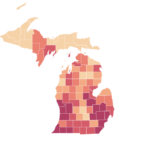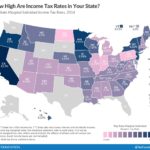Michigan ranks higher than Southern states bordering Mexico in the increase of federal arrests targeting undocumented immigrants in 2017.
According to the Pew Research Center, Michigan experienced a 52 percent jump in arrests by ICE, the Immigration and Customs Enforcement agency, in fiscal year 2017. That puts the Detroit regional ICE office ahead of the pace of increasing arrests in border areas such as Houston, San Antonio, El Paso, Phoenix, San Diego and Los Angeles.
Pew reports that ICE Enforcement and Removal Operations made 143,470 arrests in FY 2017, a 30 percent rise from fiscal 2016. But the surge began after President Trump took office in late January 2017. From his Jan. 20 inauguration to the end of the fiscal year on Sept. 30, ICE made 110,568 arrests, 42 percent more than in the same time period in 2016.
To be clear, the Detroit office’s track record on illegal immigrants ranked just 16th nationwide, with 3,409 ICE arrests. That’s partially because Michigan harbors a relative low population of legal/illegal immigrants.
In addition, ICE reports arrests geographically by “areas of responsibility” assigned to each field office in major cities. Those areas can encompass large sections of the country. The Detroit statistics are based on enforcement activities across all of Michigan and Ohio.
The Miami area of responsibility, which covers all of Florida, Puerto Rico and the U.S. Virgin Islands, saw the largest percentage increase in ICE arrests between 2016 and 2017 (76 percent). Next were the Dallas and the (Minneapolis/St. Paul) regions (up 71 percent and 67 percent, respectively). Arrests increased by more than 50 percent in the New Orleans, Atlanta, Boston and Detroit regions.
While former President Obama faced sharp criticism in the U.S. Hispanic for his administration’s aggressive deportation methods, ICE arrests declined substantially as Obama’s emphasis was almost solely on illegal immigrants with criminal convictions.
A President Trump executive order issued last year encouraged ICE enforcement of immigrants without legal documentation, regardless of their background.
Yet, the stats on ICE arrests and deportations remain murky.
ICE’s focus has changed considerably in the past eight years. According to Pew, in fiscal 2009, during the transition from the George W. Bush administration to Obama, immigrants without past criminal convictions accounted for the majority (61percent) of those arrested by the agency. Obama policies changed that metric dramatically. As the graph below demonstrates, the emphasis during the eight years of the Obama presidency flipped immigration enforcement.
That reality was again altered in 2017 when immigrants with past criminal convictions or pending charges accounted for 90 percent of all ICE arrests.
What’s more, Pew points out that immigration enforcement tactics are taking another turn under Trump:
Recent immigration arrest patterns demonstrate a growing emphasis by federal authorities on interior enforcement efforts. While ICE arrests went up significantly between 2016 and 2017, arrests made by U.S. Customs and Border Protection (CBP) — the federal agency responsible for enforcing U.S. immigration laws on the border — have declined. CBP agents made 310,531 apprehensions in 2017, down 25 percent from 2016 and the lowest total in over 45 years. Despite this decrease, CBP apprehensions still far outnumber arrests by ICE.













